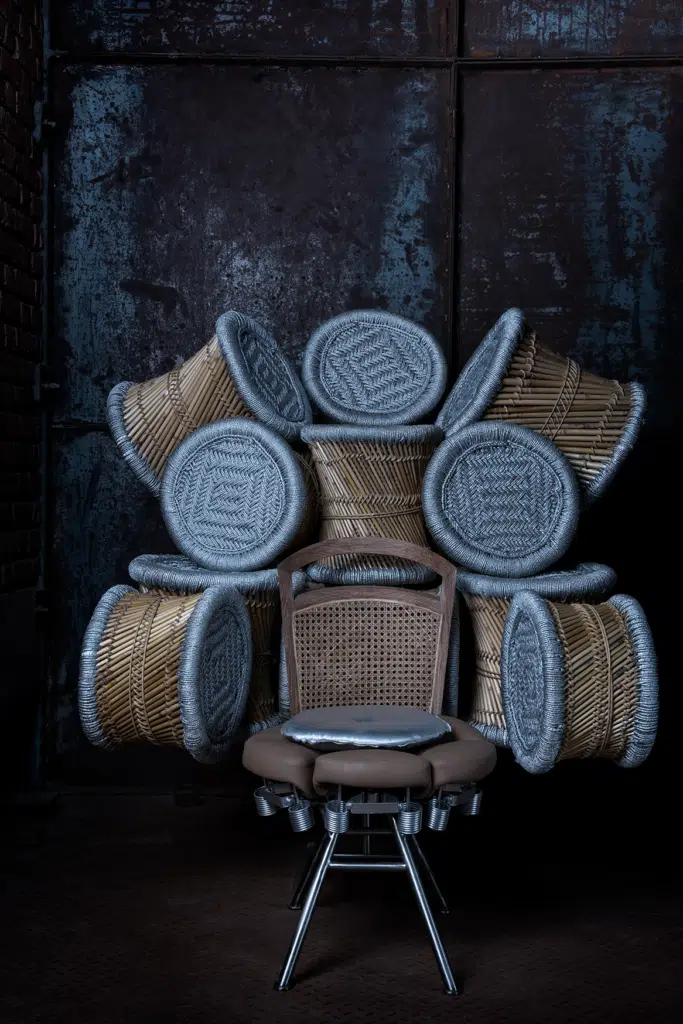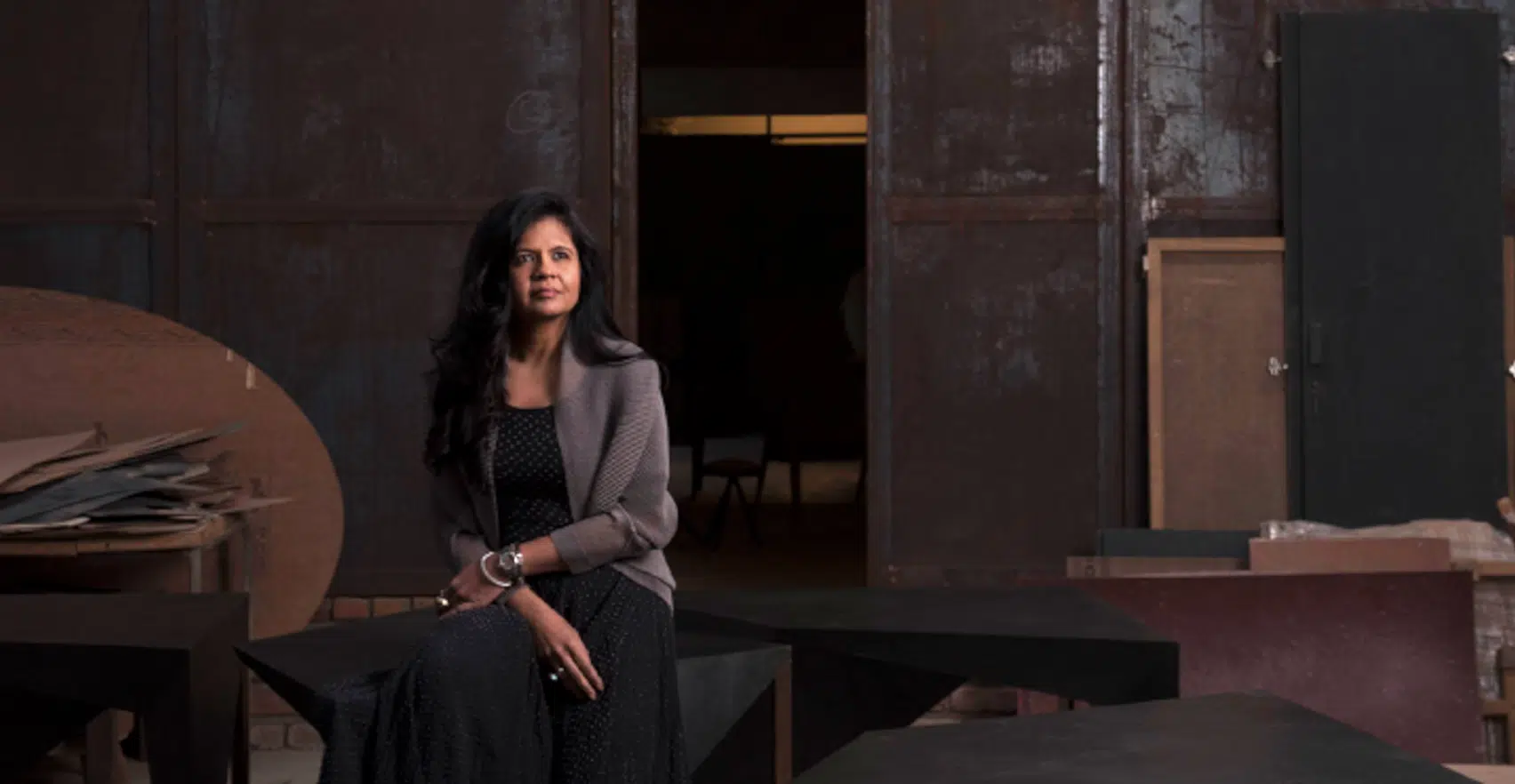Designer Gunjan Gupta reinvents perhaps the most fundamental piece of furniture one can think of — the chair. From her graduation project at Central Saint Martins, London for which she created ‘Dining Throne’ chairs wrapped in 18-carat gold and silver, to her famous ‘Mudha Wala Throne Chair’, a collage of traditional Indian cane stools in the shape of a throne — each piece in Gupta’s repertoire presents a new and witty take on everyday objects. Throughout, the focus remains on marrying Indian craft with luxury, experimenting with objects like matkas, lotas and kulhads to create innovative pieces of collectible design.
No stranger to the international design scene, Gunjan Gupta shares stories about the evolution of the landscape, and how her practice has grown in parallel to a market that is increasingly embracing talent from the Global South.
There is a delineation between Gunjan Gupta, the design entity, and Studio Wrap, your interior design studio. Please tell us more about this.
“Gunjan Gupta” emerged simply with a set of collectible design objects I made for a gallery show, where I was spotted by Rossana Orlandi. She presented the collection at her Porto Cervo space in Sardinia and we took it to fairs like Design Miami/ Basel in Basel, Switzerland. I also started receiving requests from institutions to talk about furniture and luxury craft from India. Soon, the objects catapulted from the portfolio into the gallery.
I’ve always wanted to build a holistic design practice that encompasses collectibles, interiors and products. Interior designing widens the application of my creativity beyond the wildly creative design-art objects. Projects at Wrap act like experimental runs, where I can test new ideas in collaboration with my clients so that they get to possess something unique, or what I’d like to call discernibly bespoke.
When did you know you wanted to be a designer?
In my mother’s kitchen, when I was six years old. I used to help my mom set the table, and I would inevitably mix-and-match sets. She never questioned that, and often encouraged it. Without that sense of freedom and play, I don’t think I would have chosen this line of work.

Gunjan Gupta, Muda Wala Throne Chair. Courtesy of the designer.
What changes do you notice most about the design worlds of 2006 and 2023?
There was really no concept or ongoing dialogue in the world on craft back then. We were in a world of highly sophisticated manufacturing but there was really not much else. When I would knock on someone’s door as a designer, the response would be: “Indian? Designer? Woman?” There was a solid two-foot wall between myself and the world at the time.
Compare that with The Women in Design exhibition at the Vitra Design Museum in 2021. I was honoured to be part of it; it really warmed my heart and made me feel like a part of a bigger picture. The exhibition was put together during a pause in exhibitions because of the COVID-19 pandemic, and the women in the Vitra team took a step back and assessed their archives. They actually went out into the world and collected women designers to add to their collections. I literally fell out of my chair when I got the call to be a part of the permanent collection of chairs at the Vitra Design Museum (laughs).
The ‘bicycle throne’ is one of your most iconic creations. How did it come about?
The idea of the bicycle throne emerged in a workshop in Amsterdam for Droog Design, where I was invited along with designers from other emerging countries to be part of a show called Urban Play. Each designer had to bring a cultural element from their country into Amsterdam. I wanted to focus on the bicycle, and contrast its use in the two countries. In India, a bicycle is way more than just a mode of transport — it is a vehicle for an entire family, a mobile shop, an object whose parts can be recycled to create new objects. We created a workshop called recycycle cycle to honour these traditions.
Talk to us about your relationship with the chair.
The chair has historically been symbolic of status and hierarchy in India – as we are a society that sat, slept, socialised and ate on the floor. British art historian Sir George Birdwood has famously said that “the great art of furniture is to live without it”, commenting on India’s lack of furniture during his visit in the 19th century. Mattresses and trunks were really the only pieces of furniture Indians used historically. An elevated seat was reserved for the ruling classes and not for comfort. I use this symbolic value of the chair to tell stories that are subversive.
How Indians live(d) is a recurring theme in your work, and you explore it from the ‘low’ to the ‘high’ cultures. Tell us a bit about your exploration with street objects.
I see the street as a place of ingenuity and creativity – an ever-evolving landscape that captures the essence of 21st century India in which the past, present and future collide. Mastercraft and jugaad [innovative and street-smart problem solving] have framed my philosophy and my engagement with material and form. Jugaad for me has always been about the philosophy of necessity and how it’s lent itself to a certain energy, an aesthetic, a juxtaposition which is so unusual and unique. A lot of countries have this approach but the Indian way remains special and that’s what took me to the streets.
What advice do you have for young collectors of design in India?
Ask if the object tells a story and how it’s made. Take a risk! It’s never just about functionality. You’re never just buying a chair. If you want something, it’s because it’s representative of a moment in time.
What’s a design object you wish people would use more?
The Godrej Cupboard.
Which designer, alive or dead, would you invite for dinner? What would you feed them?
I would love to invite Brancusi for an experiential home cooked dinner served in my Vertical Thaalis. The menu would include a simple ayurvedic vegetarian meal.
Gunjan Gupta was born in Mumbai in 1974. Her work will be part of India Art Fair’s inaugural Design section at the 2024 edition, along with other pioneers in the field.


